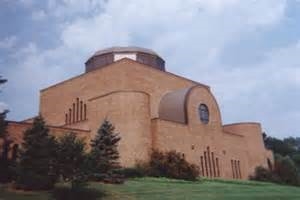United Hebrew Congregation
of St. Louis
On Rosh Hashanah in 1836, the first minyan (prayer quorum) in St. Louis, Missouri was founded at 2nd and Spruce Streets, above Max’s Grocery & Restaurant. Services were led by Louis Bomeisler.
In 1841, this minyan became the United Hebrew Congregation, the first congregation established west of the Mississippi.
Herman Van Beil was instrumental in organizing the congregation, which began as an Orthodox synagogue.
In 1840, the first Jewish cemetery was dedicated in St. Louis, at 2700 Pratte Avenue, paying $200 for the land.
The Ladies Hebrew Benevolent Association of the United Hebrew Congregation was also established at this time.
The First Building – 1848
In 1848, the United Hebrew Congregation opened its doors on Fifth Street between Washington and Lucas.
This was the former home of the North Baptist Church.
In 1854, the congregation hired its first Rabbi, Dr. Bernard Illowy, who had been chaplain to the Austrian Court-Jew Oppenheim family, as well as the head of a beth din (rabbinical court) and a yeshiva (Jewish academy)in Austria.
The Second Building – 1859
In 1859, the congregation moved to Sixth Street between Locust and St. Charles.
In 1866, it purchased Mount Olive Cemetery, located on the corner of Canton Ave. and North & South Road.
In 1878, United Hebrew Congregation joined the Union of American Congregations (Reform movement).
The Third Building – 1881
In 1881, United Hebrew Congregation moved to a larger facility at Twenty-First and Olive.
In 1885, the congregation withdrew its membership from the Union of American Congregations, the same year the Reform movement devised the Pittsburgh Platform, which called for Jews to adopt a modern approach to Jewish and which many rabbis found objectionable.
The Fourth Building – 1903
In 1903, United Hebrew Congregation moved to Kingshighway and Von Versen.
In 1904, the congregation renewed its membership in the Union of American Congregations, and remains affiliated to this day.
The Fifth Building – 1927
In the early 1920s, United Hebrew Congregation bought land across from Forest Park for their new synagogue building.
Some residents protested this building, taking their lawsuit to the Missouri Supreme Court.
The suit was dismissed and the new synagogue was built.
In 1927, the new Byzantine style building at 225 S. Skinker was dedicated.
Designed by Gabriel Ferrand, it was one of the largest synagogues in the United States.
United Hebrew Congregation became the first Reform synagogue with its own Cantor.
In the early 1950s, they added an educational building to the synagogue campus.
In 1960, they changed the name of Mount Olive Cemetery to the United Hebrew Cemetery.
The building currently houses the Missouri Historical Society.
The Sixth Building – 1989
In 1977, United Hebrew Congregation bought land in West St. Louis county and built the Ann and Ullus Gudder Educational Building to house its school facilities.
In 1987, the congregation began constructing a new synagogue to accomadate its growing population.
In 1989, the present home of United Hebrew Congregation was dedicated at 13788 Conway Road in Chesterfield.
In 2007, the congregation commissioned the first Torah scroll completely written by a soferet (female scribe), Jen Taylor Friedman.
Rabbi Brigitte Rosenberg is the current spiritual leader of United Hebrew Congregation (2017).
Sources
- Walter Ehrlich, Zion in the Valley: The Jewish Community of St. Louis, Volume 1 (Columbia, Mo: University of Missouri Press, 1997).
- United Hebrew Synagogue, http://www.unitedhebrew.org/
- “Our Building,” Missouri History Museum and Research Center, http://www.mohistory.org
Samantha Silver is the curator for this United Hebrew Congregation exhibit.


